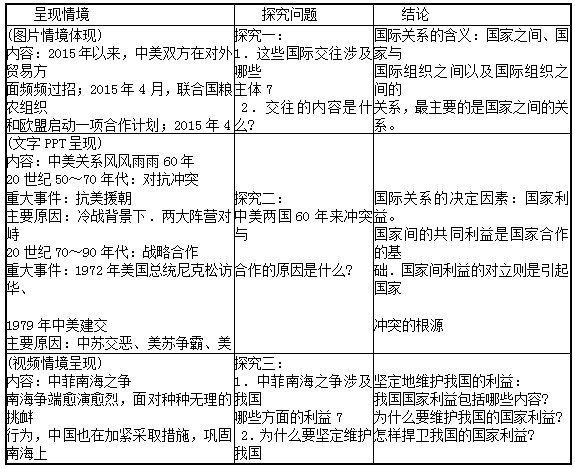根据提供的信息和语言素材设计教学方案,用英文作答。
设计任务:请阅读下面学生信息和语言素材,设计一节课的教学方案。教案没有固定格式,但须包含下列要点:
?teaching objectives
? teaching contents
?key and difficult points
?major steps and time allocation
?activities and justifications
教学时间:45分钟
学生概况:某城镇普通中学九年级(初中三年级)学生,班级人数40人,多数已经达到《义务教育英语课程标准(2011版)》四级水平,学生课堂参与积极性一般。
正确答案及解析
正确答案
解析
Teaching Content: Talk about the personality and write a personality survey. Teaching Objectives :
Knowledge objective
(1) Key Vocabulary
pretty, social, bother, slight, in the slightest, fairly, plenty, plenty of, get along with, listener
(2) Reading
(3) Writing
Ability objective
Students should improve their ability of reading comprehension and writing.
Emotional objective
Students can learn that being a good listener is an art.
Teaching Key Points:
Master the key vocabulary and the point of writing and reading
Teaching Difficult Point:
How to write a personality survey
Teaching Methods :
(1) Practice method
(2) Pair work
Teaching Aid: A projector
Teaching Procedures :
Step 1 Leading-in (5 minutes)
The teacher asks "what would you do if ...? "
(1) the teacher asked you to give a speech in front of the whole school
(2) your brother borrowed your clothes without permission
(3) someone asked you to be in a movie
(4) you wanted to be friends with a new student
Encourage students to give different answers to each question. Those who speak out the most answers will get a
reward after class.
(Justification: Set a happy English learning atmosphere for students, and make a preparation for today's class.)
Step 2 Presentation (20 minutes)
3a
Show the vocabulary words on the screen by a projector.
pretty adv.相当;颇;非常social adj.社会的;社交的
bother v.打扰:扰乱slight adj.微不足道的;极不重要的
in the slightest一点儿也;根本fairly adv.相当;完全
plenty adj.很多的:足够的plenty of很多的;足够的
get along with与……相处listener n.听者;收听者
Explain the words one by one and have students repeat them several times.
Call students' attention to the personality survey results in the box. Set a time limit of two or three minutes.
Have students read the three paragraphs silently. Meanwhile, write the new words on the blackboard. Ask students to look at the questions and answers on the survey in Activity 2a.
T: The letter "a" answers all describe one type of person. The letter "b" answers describe another and "c" still another type.
Read the Activity 3a instructions to the class. Ask students to reread the personality survey results and decide which letter goes in each paragraph. Point out the sample answer.
Get students to complete the activity on their own.
Check the answers.
3b
Read the instructions to the class.
Invite a student to say the example to the class.
If a friend said something bad about you, would you ...
a. talk to the friend right away?
b. say nothing?
c. think about what he or she said?
T: What kind of person is Question A asking about?
Ss : Outgoing.
T: What about b?Ss: Shy.
T: What about c?Ss: Pretty confident.
T: You are to write your own personality survey. You can write any questions you want, but each question must be about a different personality type.
Give another example on the blackboard. If a friend misunderstood you, would you ...
a. tell him / her it is a misunderstanding at once?
b. want to explain to him / her, but have no courage?
c. invite him / her to dinner and explain?
Get students to work individually. Remind them to use the ones in the book and on the blackboard as a model.
As they work, move around the room checking their works and offering language support.
Part 4
Read the instructions to the class.
Point out the sample conversation in the box. Invite a pair of students to read it to the class.
SA: How many people would talk to the friend right away7
SB: Three. And two people would say nothing.
(Justification: The process of this step provides reading and writing practice using the target, arid introduces key vocabulary words and provides reading practice using the target language.)
Step 3 Practice (15 minutes)
Divide the class into groups of five. Ask students to give their survey to each person in their group, and circle the answers.
T: Having given your survey, talk aboot what you learned. Use the sample conversation in the box as a model.
As the groups work together, walk around the room offering any help they may need.
Ask several students to read his / her question and tell the class about the results.
(Justification: This activity provides oral practice using the target language. )
Step 4 Summary and Homework (5 minutes)
Summary: In this class, we've learned some new vocabulary words. And we've also done much reading and writing practice using the target language.
Homework: Ask students to reread the three paragraphs under the headline personality survey results for further comprehension, and write a personality survery of ten students.
?(Justification:The summary gives a specific conclusion of this class and the homework helps students consolidate the point of the class and improve their writing abilitiy. )
Blackboard Design :
1. Key vocabulary:
?pretty social
?bother slight
?in the slightest fairly
?plentyplenty of
?get along withlistener
2. If a friend misunderstood you, would you ...
?a. tell him / her it's a misunderstanding at once?
?b. want to explain to him / her, but have no courage?
?c. invite him / her to dinner and explain?
你可能感兴趣的试题
阅读下面材料,根据要求完成教学设计。

要求:请根据思想政治辩论式教学的相关要求,结合教学内容设计一个辩题,并围绕该辩题设计教学活动简案。
- 查看答案
下面是某思想政治教师制作的课前5分钟学生时政演讲评价量表。

- 查看答案
材料:下面是某思想政治老师关于“国际关系的决定性因素”的教学设计片段。

问题:请运用思想政治课教学理论,对本教学片段中问题设置的优缺点进行评析,并针对问题设置存在的缺陷提出修改建议。
- 查看答案
良好的开头是成功的一半。为提高课堂教学的有效性,思想政治课教师在导人时应遵循哪些基本要求
- 查看答案
当前学术界有很多理论观点,争论很大。面对不同的学术观点,是应该据理力争、坚持己见,还是应该尊重差异、包容互鉴。请你从中选择一个观点并从认识论角度阐述你选择的理由。
- 查看答案